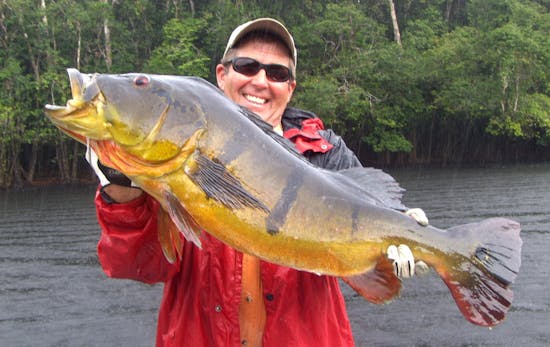 See
more of the story
See
more of the story
Beginning in 1965 and continuing through 1986, "The American Sportsman" was broadcast on ABC, hosted by Curt Gowdy.
Gowdy was an outdoorsman and broadcast journalist who stumbled across the show's concept when ABC sent him to Argentina to fish with world famous angler Joe Brooks. The segment was slotted in an episode of ABC's "Wide World of Sports."
"The public reaction was so strong a new series was born," Gowdy, who died in 2006 at the age of 86, later recalled.
At its core, "The American Sportsman" was a call to adventure that reflected and validated the interests of its viewers, while also transporting them, vicariously, to places they might never visit. In those respects, the show was a film version of American outdoor storytelling that began around campfires in the 1700s.
So much has happened in the centuries since, particularly in the past 50 years, that Gowdy might not recognize the outdoors broadcasting "industry."
Now, as many Minnesotans settle in for a long winter of more "watching" than "doing," they'll see changes among hunting and fishing shows.
Some hosts are handing their "star" duties to sons or daughters. And more outdoors viewing options than ever are available online.
• • •
Fresh and wholesome as the adventures it portrayed, "The American Sportsman" was broadcast largely without commercial references. The story was the focus of Gowdy's show, as were the people he featured with a gun in hand, or rod and reel. Bing Crosby was among these, as were William Shatner and others.
Fast forward to 1979, when "In-Fisherman Television," hosted by Brainerd's Al Lindner (and his brother, Ron) first aired.
A spinoff of the Lindners' In-Fisherman magazine, "In-Fisherman Television" wasn't TV's first fishing show; Southerners Bill Dance and Roland Martin, among others, were already on the air. But the Lindners carved out a unique space: As was the goal with their magazine, their intent was to teach viewers how to catch fish.
In the years since, Minnesotans have played key roles in the evolution of outdoors TV. Ted Capra was among these, as are, more recently, Lee and Tiffany Lakosky and Pat and Nicole Reeve. So, too, Babe Winkelman of Brainerd, who started his broadcast, "Good Fishing," in 1980.
Winkelman caught a break in 1983 when the makers of Deep Woods Off! insect repellent cast him as a burly outdoorsman-spokesman. Catapulted onto a national stage, Winkelman soon began filming half-hour fishing broadcasts, followed, in time, by a hunting show, "Outdoor Secrets."
Unseen to viewers of outdoors TV shows are the financial negotiations that underpin their broadcasts. In most cases, the air time or "space" on a station or network is bought by a show producer, who then sells advertising to pay for a program's costs, while also, hopefully, yielding a profit.
Over time, in this matrix, advertisers have required more and more product placement and endorsement within the programs themselves. Depending on a viewer's sensibilities, the sight of a TV host wearing branded clothing while touting the advantages of, say, a particular fishing line or lure is either mildly off-putting or a complete turnoff.
Mitch Petrie, vice president of programming for Outdoor Sportsman Group Networks, which owns Outdoor Channel and Sportsman Channel, says outdoors TV is unique in its relationship to advertisers.
"The outdoors TV market was built on serving the outdoor enthusiast," said Petrie, who lives in the Twin Cities. "The people who were paying for it were, and are, for the most part equipment manufacturers. Some shows can be overly commercial. But most viewers have become accustomed to it."
For 20 years, Larry Dahlberg of Taylors Falls owned and hosted "The Hunt for Big Fish." An expert angler and lure inventor, Dahlberg, who filmed "The Hunt" in 89 countries, got his start at In-Fisherman.
"In our first years of 'In-Fisherman' shows, we were pulling a 40 share in the Twin Cities," Dahlberg said. "The commercial stuff wasn't included. If you were an advertiser, our program gave you an environment in which your product fit. Then, over time, it changed. More shows competed for the same advertising dollars. Advertisers in turn required their products to be placed in broadcasts. There isn't any question this has had a major negative impact among viewers."
When retired Star Tribune outdoors columnist Ron Schara founded his long-running program "Minnesota Bound" in 1995, he said he didn't want to produce "just another fishing show."
"Variety has been important to our longevity," Schara said. "We might have an initial segment on a deer camp. But the next segment of the same show might be about a state park. Fifty percent of our viewers are women. We're not gutting deer on TV. We're telling stories. When it's all said and done, it's the story that's important."
However much today's outdoors shows might differ from "The American Sportsman," tomorrow's adventure broadcasts likely will be more different still.
They already are.
YouTube and the many social media outlets available today to (mostly young) outdoors broadcasters essentially carry no overhead costs. Meaning a kid in North Dakota or Texas who uses an iPhone to film, say, a duck or deer hunt, is now competing with major outdoors TV broadcasters for "eyeballs."
Some of these new-age outdoors broadcasters also are getting paid by advertisers to be "social influencers" — product peddlers, by another name — further dividing advertising money.
Winkelman is among legacy outdoors TV hosts caught up in these rapid changes. His shows have been off the air for a year while he rights himself financially, he said, with an eye toward streaming his programs on the internet.
"It's interesting," said Petrie, "that people who post hunting and fishing videos on social media think, mistakenly, that the outdoors TV personalities they watched as kids got paid to hunt and fish.
"They didn't. They got paid to deliver audiences to advertisers and to promote products, and they did it by hunting and fishing."
danderson@startribune.com





